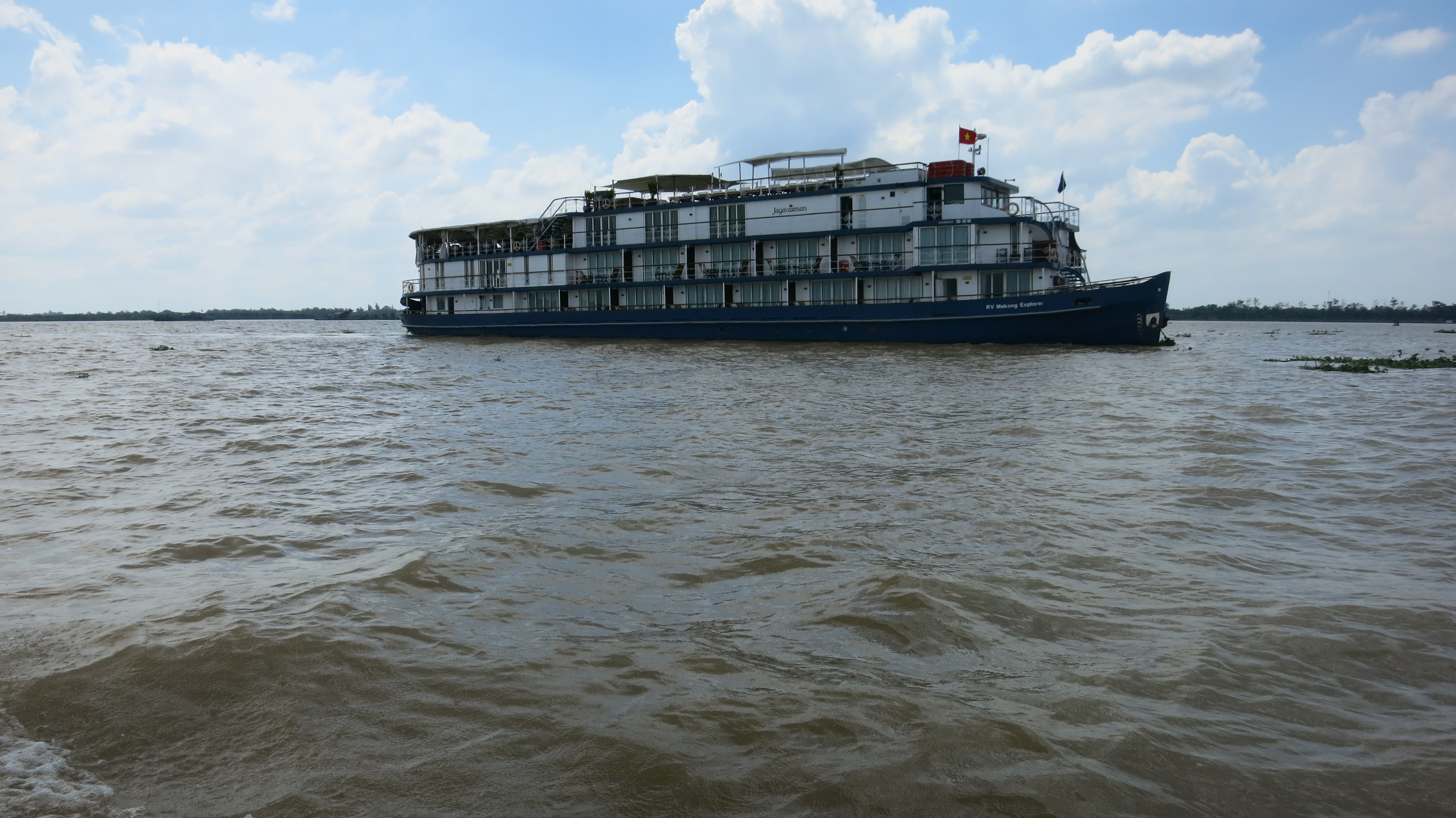
19 Nov TIO SE Asia: Dispatch 6, Mekong, Last Days
If you’re happy and you know it clap your hands.
Stomp your feet.
Quack like a duck.
Do whatever you like – but emote enthusiastically.
While smiling from ear to ear like it’s Christmas.
“If you’re happy…etc.” appears to be the (unofficial) national anthem of Cambodia.
That is the song children sang to us when we visited their schools on our cruise.

Adam and Children
I’ve mentioned before that our wonderful Cambodian guide Adam was a teacher before he started leading Jayavarman guests around the country he so clearly loves. Apparently you can take the teacher out of the classroom, but you can’t take the classroom out of the teacher: Adam obviously found his bliss teaching kids hungry to learn and his passion was infectious.
On the 17th, he brought us to the town of Kampong Tralach, where we docked the night of the 16th. They sang “If You’re Happy…” to us in Khmer; we sang back in English.
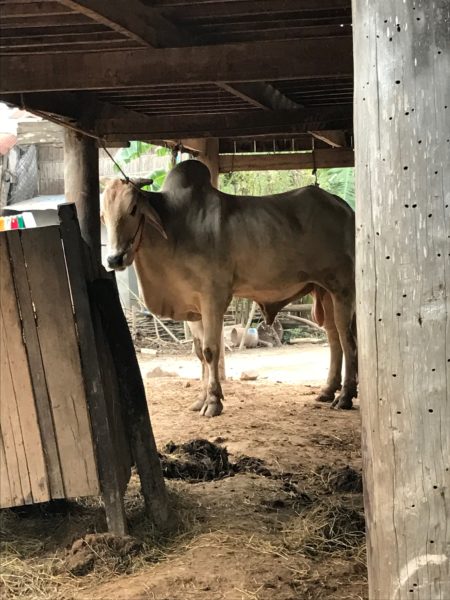
A few days later, we strolled through the rural community of Angkor Ban at dusk, a corner of the map where white oxen are parked in every yard and appear to outnumber the people. Locals had lit fires in their front yards hoping the smoke from extinguished flames would discourage mosquitoes. (The fear here is Dengue Fever.)
Before marching in lock-step down a dirt road that led to the local schoolhouse, an old man invited us into his home to see how he lived (very simply) and admire photos of his family.
At the school, Adam instructed us to mingle and help the kiddos with the “sh,” “ch” and “th,” sounds that appear to be very difficult for Cambodians (of any age) to pronounce, so we posted ourselves on different benches next to the students who were over-the-moon to be able to practice English with so many English-speaking people.

What this trip has been all about, what the Jayavarman team made a point of pride, was to find as many opportunities as possible for close encounters with their culture. That becomes particularly important now, a time when some people in some countries, including a cadre at home sweet home, are attempting to cocoon themselves inside their borders.
For the past weeks in SE Asia and certainly on our week-long cruise, everyone we have met, on and off the Jayavarman’s Mekong Explorer, has demonstrated genuine warmth and a deep curiosity about who we are and why we are visiting their country, town, or village.
Even those with limited English managed to communicate with smiles and bows. Everyone has seemed very curious about our culture too and posed questions to whomever was our guide du jour: at a monastery, a young Buddhist monk asked Adam to ask us about ISIS and whether we felt safe at home; he wondered whether the religious differences in our group caused any problems.
A women we met in Kampong Chichang, a small town on the bank of the Meklong, made a pot by turning her body into a wheel. She drilled us as she twirled around the lump of clay set on the stump of a tree. As did her mom, who held the woman’s one-year-old child in her arms.

Making the Pot- No Wheel
When they spot us hairy creatures with big noses (because we eat potatoes, instead of rice, Adam quipped) in a crowd, children everywhere greeted us enthusiastically with the one word they all seem to know, “Hello”; they hi-fived with gusto whenever they could.
One if by land…
Two, if by trishaw…
Or two-wheeled ox-cart…
Or e-bike…
Or tuk tuk, the final mode of local transportation the crew wanted us to experience, because, well, however uncomfortable on rutted and/or crowded roads, that’s how locals get from point A to B.
So yes, we saw what the guide books tell everyone to see, (list below for last two days on the boat), but the rich juice on our cruise up the Mekong was the many “off piste” experiences.
On our last day, for yet another example, Buddhist monks came on board to bless the guests and crew. For their trouble, we all donated to their monastery (which we had visited); they in turn tied a piece of woven red yarn on our wrists (without touching the women’s skin, which is forbidden).
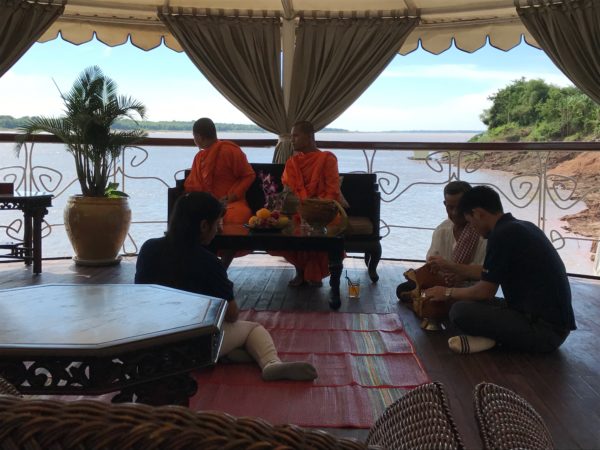
Our new bracelets are to ward off evil spirits.
Will report back when we return home…
Later the same day, our last, children from the Organization for Basic Training, came on board to sing and dance for us – and yes, again, solicit support. Any why not? Just $2, can make a difference to these kids who grew up with nothing, no chance for education without scholarships. Now they told us, one by one, they dream of becoming doctors, football players, teachers – and waiters on a boat like ours.
In Kampong Cham, Adam’s home town, we visited Wat Hanchey, resurrected from the ruins of a 12th-century Angkorian-era temple, destroyed by the Khmer Rouge, who used the site for interrogation – and the fields below for their favorite sport: killing fellow countrymen.
Families of long-tailed macaque monkeys live on the temple site on Man Mountain. Babies were everywhere; everywhere else, amorous couples were, well, up to monkey business (hence all the babies).
Adam warned us to keep our distance, but as we were leaving the site, one enterprising macaque leaped up to grab a water bottle out of the hands of one of the women in our group. Adam advised her to toss it quickly. The monkey caught the bottle, opened it, and drank lustfully. For good measure, someone else left a back-up.
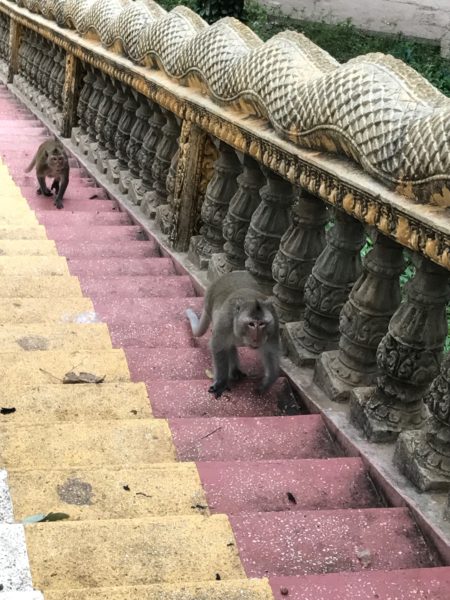
On our last evening, Friday, the 18th, guests and crew got together for a farewell presentation, including a dance party at which the Jayavarman team taught us to shake our tail-feathers Cambodian style. (It involves mudras.)
The banquet that followed included one of the best rack of lamb offerings any of us had ever eaten. And that included the Kiwis. Chef Andy, who is Indonesian, should be declared a national treasure.
Thanks again to Inspiration Cambodia; Jayavarman cruise, an adventure that was all about subtext, what happens between the lines of the guidebooks.
We left with a few silk scarfs, lots of head pictures, indelible memories, and new friends.
Next stop: Siem Reap and Angkor Wat.
More on our itinerary on November 17 & 18:
Silk Island of Oknha Tey, where we watched the process of silk weaving from larvae to finished product and learned why Chinese silk is inferior to Cambodian silk. (Chinese use dyes and technology; Cambodians use hand labor and a comb-like weaving process to lift and alternate the different colors to create the patterns.Yes we bought scarves (to support the local economy). 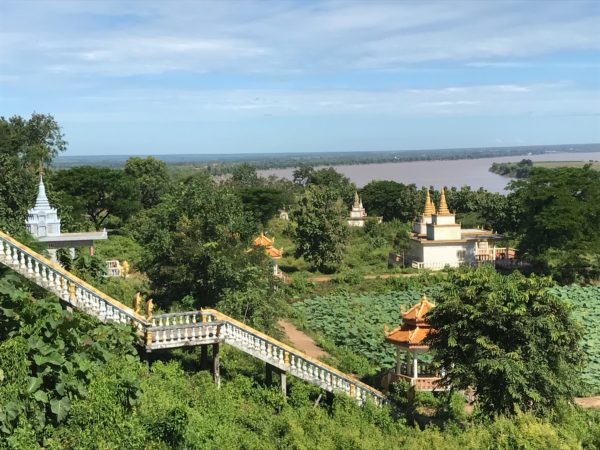
Wat Hanchery. We climbed about 303 steps to get to the hilltop where the temple complex is located.
Wat Nokor, a recently renovated monastery dating back to the 12th century, with buildings honoring both Theravada and Mahayana Buddhism. Theravada is the principle religion of Cambodia (also Laos, Thailand, Myanmar and Sri Lanka).


Sorry, the comment form is closed at this time.